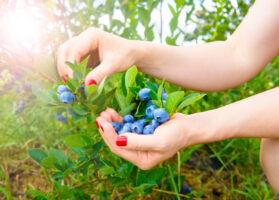Stronger domestic blueberry season anticipated for 2024

Overview of blueberries in the U.S. market, complemented by charts from Agronometrics. Original published on November 16, 2023.
Blueberries are top of mind given the shortages the retail shelves have seen this fall, though that’s largely to do with the shorter supply from import countries such as Peru. Kasey Cronquist, president of the U.S. Highbush Blueberry Council and the North American Blueberry Council, shares what lies ahead for the 2024 domestic blueberry season.

Source: USDA Market News via Agronometrics.
(Agronometrics users can view this chart with live updates here)
Q: Realizing it’s very early on, what are you seeing at this point for the 2024 domestic blueberry season?
A: The predictions we’re hearing from our growers suggest that the 2024 season should be better than the 2023 season. The Pacific Northwest was down and we’re not anticipating that again unless there’s a weather event. As long as things go well, the domestic season is anticipated to be larger than last season which we’re all looking forward to.
Q: Any regional updates?
A: Washington, specifically in the Eastern part of the state, there are some new plantings there. There are some new plantings on the Western side but most of that is in the Eastern half. That’s where you’re going to see your growth in the Pacific Northwest.
We also just saw a tremendous season in Georgia. They had a record season so that’s a state to watch. When they have a great season like they did this year, it can push up to what they had which was a 97 million pound crop–a significant bump for them.
Q: Looking back at 2023’s season, what were your successes and challenges?
A: Along with Georgia reaching its highest production level in its history, 2023 will be recognized for the increase in our FOB pricing at retail. As we’re watching the supply challenge of the Peruvian crop, the pricing on the back half of the season has gone up quite a bit due to demand. People really want their blueberries and pricing has gone up accordingly.
Like a lot of crops, we had some weather challenges that have affected the Pacific Northwest season in the last couple of years. We see a lot of opportunities and challenges in pollination issues from year to year and we’re working really hard right now to look at different technologies in the area of pollination.
Q: Going into 2024 is there anything that growers and shippers should be particularly mindful of for the upcoming season?
A: We’re mostly thinking about the way we monitor the fresh and processed markets. The better we can get at predicting our crop in our yields, the better we can manage the supply side that ebbs and flows. It’s important we’re doing everything we can to monitor those markets as part of ensuring the success of those supplies.
In the fall, we’ve experienced what it’s like to not have the shelf filled with blueberries and the demand that comes from retailers who want to supply their customers with blueberries. This is unique to this season, particularly with Peru, and I hope that in 2024 we can get back to stability that runs throughout the domestic season. We’ll be watching closely how this Peruvian season affects the back half of 2024–but it won’t look like it did this season. We just need to work together as an industry to monitor the supply coming in.
Q: Finally any other changes coming in 2024, such as varietals?
A: In blueberries, there are many different varieties in the field and being cultivated for introduction into the market. This is going to make the next five years of blueberries really exciting but also challenging because we still have a lot of varieties that are in the ground and part of the mix throughout the year so growers are having to make choices about these new varieties coming out and whether or not they want to invest in them. It’s where the innovation is for sure.
There’s also a lot of promotion work being done by our team whether it’s the ‘Grab a Boost of Blue’ campaign or the findings in our research in diet and health. We worked with a number of retailers during National Blueberry Month where some saw a 33 percent increase year over year against the rest of the market which helped highlight what just a bit of marketing can do for increasing consumption.
We’re an industry that’s in just under 50 percent of households and that’s a big runway still ahead for blueberries. Strawberries for example have a much higher household penetration than what we’re at today. We also know our current consumers are only enjoying about 6.5 pounds of blueberries a year. Imagine if we can get our current buyers eating 1-1.5 lbs. of blueberries a month. That’s a realistic goal for this industry.
The News in Charts is a collection of stories from the industry complemented by charts from Agronometrics to help better tell their story.
Access the original article with this (Link)






